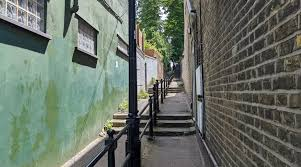Introduction
London is a city that reveals its secrets to those who know where to look. Beneath the bustling streets and famous landmarks lies a network of hidden alleyways that have played crucial roles throughout history. These narrow passages, often overlooked by modern tourists and even residents, provide a glimpse into the past and offer stories of intrigue, rebellion, and transformation. In this article, we’ll explore the legacy of London’s hidden alleyways, uncovering their historical significance, cultural impact, and the unique stories they hold.

The Historical Importance of London’s Alleyways
A City Built on Alleyways London’s alleyways are more than just winding passages between buildings; they are the veins of the city’s history. For centuries, these alleys served as the lifeblood of daily life, providing shortcuts for workers, escape routes for rebels, and hideaways for those seeking anonymity. Many of these paths date back to medieval times, providing direct routes through the dense cityscape. Their narrowness reflects the era’s need for privacy and security amid the densely packed buildings and bustling streets of London.
Evolution from the Medieval Period to the Modern Day During the medieval period, London was a maze of narrow, winding streets and alleyways, reflecting the rapid expansion of the city. As trade grew, the need for such passages increased alleyways offered quick routes to workshops, markets, and homes, often hidden away from the prying eyes of tax collectors and officials. Over time, these passages became more integrated into the city’s infrastructure, evolving from mere shortcuts to key features in the urban landscape. Today, many of these alleyways are hidden in plain sight, waiting to be rediscovered.
The Role of Alleyways in London’s Social and Economic History
Alley’s Role in Trade and Commerce London’s hidden alleyways were vital for trade and commerce, particularly in the medieval and early modern periods. Merchants used these narrow paths to move goods discreetly, avoiding taxes and the gaze of government officials. The proximity of alleyways to markets allowed traders to set up stalls quickly and efficiently, creating bustling commercial zones within the city. This movement not only facilitated commerce but also fostered community many alleyways were named after tradesmen or guilds that operated nearby.
Shelters for the Working Class In the 18th and 19th centuries, London’s alleyways also became home to the city’s working-class population. These narrow streets provided affordable housing for workers, especially those in low-paying jobs like sweeps, chimney sweeps, and market porters. The close quarters and shared amenities in these alleys led to a sense of community among residents, but also to cramped and often unsanitary living conditions. Despite this, alleyways were crucial for social life, where communities developed their own traditions and networks.
Alleyways as Centers of Rebellion and Resistance
The Peasants’ Revolt of 1381 The narrow streets and hidden alleyways of medieval London provided refuge for those involved in the Peasants’ Revolt of 1381. As the movement sought to challenge the feudal system and the authority of the monarchy, rebels found it difficult to express their discontent openly. Alleyways allowed them to meet in secret, plan their actions, and escape the wrath of royal forces. These passages became symbolic of resistance an undercurrent of discontent running beneath the surface of the city.
The Gordon Riots of 1780 In the 18th century, London’s alleyways played a crucial role during the Gordon Riots, one of the largest and most violent popular protests in British history. As protesters clashed with the government over anti-Catholic laws, they utilized the city’s labyrinth of streets and alleys to avoid capture by the military. The riots were a direct response to fears of Catholic emancipation, and the alleys provided both a defensive network and a place for rebels to regroup.
Alleyways as Cultural Hubs
Artisans and Craftsmen Throughout London’s history, alleyways have served as cultural hubs where artisans and craftsmen practiced their trades. From leatherworkers and silversmiths to glassblowers and printers, these narrow streets provided workshops for specialized crafts. The close proximity of these workshops fostered a vibrant community of creators, often leading to shared knowledge and the development of new techniques. Today, some of these trades have disappeared, but their legacy lives on in the stories and traditions passed down through generations.
A Bohemian Lifestyle in the 19th Century In the 19th century, many of London’s alleyways became known for their bohemian lifestyles. Artists, poets, and writers sought refuge from the city’s hustle and bustle in these hidden corners. Places like Fitzrovia and Soho were known for their literary salons and pubs, where creative minds gathered to discuss ideas and share works. These alleyways became synonymous with a freedom of expression, providing the space for unconventional thoughts to flourish.
Rediscovering London’s Hidden Alleyways Today
The Revival of Interest in London’s Secret Passages Today, there is a renewed interest in exploring London’s hidden alleyways, both by tourists and locals. Organizations like the Museum of London and private tour guides offer walking tours that take visitors through these hidden passages, revealing their historical significance. The revival of interest is not just about discovering the past; it’s about understanding how these spaces influenced the development of the city.
Walking Tours and Themed Events Walking tours focused on London’s hidden alleyways often include storytelling elements that bring history to life. Tour guides use anecdotes, historical photographs, and old maps to paint a vivid picture of what life was like in these passages. Themed events, such as talks and exhibitions, provide deeper insights into specific aspects of these alleyways whether it’s the art of cobbling, the life of a sweeper, or the tales of rebellion that once echoed through these narrow streets.
Preserving the Legacy
Challenges in Conservation While there is growing recognition of the value of these alleyways, preserving them is not without challenges. Urban development pressures, changes in building use, and modern construction techniques threaten to obscure or destroy these historic pathways. Efforts to maintain and protect these passages involve partnerships between government bodies, historical societies, and local communities. The challenge lies in balancing development with conservation ensuring that the city’s hidden stories are not lost.
The Role of Local Communities Local communities are increasingly playing a role in the preservation of London’s alleyways. Many neighborhoods have formed associations dedicated to documenting and safeguarding these passages. Initiatives include plaques, guided tours, and community-led clean-ups to keep these spaces accessible and respected. Through these efforts, the legacy of London’s hidden alleyways continues to be a living part of the city’s cultural heritage.
Also Read: The Four: The Hidden DNA of Amazon, Apple, Facebook, and Google (Hardcover) eBook Review
Conclusion
London’s hidden alleyways are more than just passages between buildings; they are the forgotten stories of the city, the heartbeat of past communities, and the site of historical rebellions and cultural expressions. As we rediscover these spaces, we are not just learning about the past; we are reconnecting with the vibrant history that shaped London into the city it is today. Whether you’re a history buff, a local resident, or a curious traveler, these alleyways offer a unique opportunity to see London from a different perspective one where the city’s secrets are hidden just around the corner.
FAQ
Why are London’s alleyways so narrow?
- The narrowness of London’s alleyways reflects the city’s medieval origins. As London grew rapidly in the 12th and 13th centuries, space was at a premium, and the need for dense, efficient urban living led to the creation of these narrow passageways.
How have the alleyways changed over time?
- Many of London’s alleyways have been widened or filled in as the city developed, particularly during the Victorian era. However, some original passages have been preserved, providing glimpses into the past.
What are some famous hidden alleyways in London?
- Examples include King’s Bench Walk, Lant Street, and Neal’s Yard. These alleyways are known for their history, quirky names, and unique stories.
How can I visit these hidden alleyways?
- Walking tours, such as those offered by the Museum of London or private guides, are the best way to explore these spaces. Online resources and maps can also provide self-guided tour options.
What role do these alleyways play in modern London?
- Today, many of London’s alleyways are not just historical sites but are used as thoroughfares for commuters, pedestrians, and cyclists. They continue to be integral to the city’s urban fabric.


